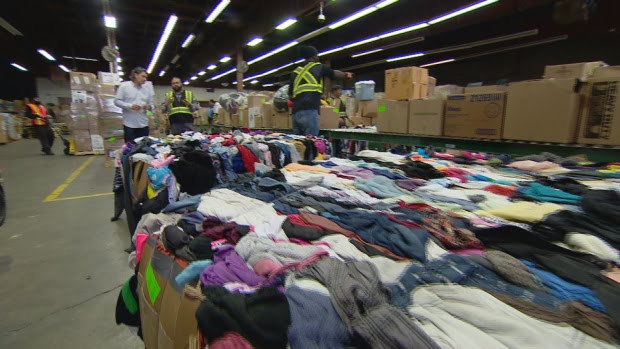Teens from high schools across the province are hoping to raise awareness about the importance of keeping old clothes out of landfills by joining the I Give A Sh!rt challenge.
The campaign encourages students to collect worn clothing and other textiles and donate them to charities such as Diabetes Canada.
The Recycling Council of Ontario says the latest campaign. which ran during Earth Week in April, kept 27-thousand kilograms of textiles from ending up in the province’s landfills.
“Textiles waste has reached unprecedented levels. Global production of new garments has reached 100 billion annually, which is double the amount compared to the year 2000.” says Jo-Anne St. Godard, Executive Director, Recycling Council of Ontario. “The #IGiveAShirt Challenge spotlights the importance and effectiveness of reuse and smart consumption, which are key actions that will keep material from being lost to disposal.”

Value Village’s Toronto Recycling Redistribution Centre in Etobicoke where some of the used clothing donated during the #IGiveASh!rt campaign was sorted. (Paul Borkwood)
Emma MacLennan-Nobrega, 16, said her fashion class at Mayfield Secondary School took part, hoping to show how recycling clothing can have a big impact on our environmental footprint. Mayfield, located in Caledon, is one of about 90 schools across the province to join the campaign.
Saad Saiyed runs Value Village’s Toronto Recycling Redistribution Centre in Etobicoke. The warehouse is where donations from more than a dozen stores are brought for sorting. (Paul Borkwood)
MacLennan-Nobrega said while fashion is important to kids her age, it’s wasteful to think of clothing as a disposable product.
“We use it and we think it’s not worth anything anymore and we throw it away without even thinking about it,” she said.
Campaign partner Value Village helped sort through all the donations.
Saad Saiyed runs Toronto Recycling Redistribution Centre in Etobicoke, where donations from more than a dozen Value Village stores are brought for sorting every day.

Some of the clothing students at Mayfield Secondary School were able to save from going to the dump during the #IGiveASh!rt campaign. (Recycling Council of Ontario)
“It takes something like 700 gallons of water to make a cotton shirt, so when you aware of that you think about what 700 gallons would mean,” he said.
The Recycling Council of Ontario estimates that that’s about enough water to last a person five years. A pair of denim jeans takes up even more water to produce — as much as 1,800 gallons (about 6,814 litres).
- Textiles are the next frontier in recycling for cities looking to cut waste
- Torontonians making ‘mistakes’ with what ends up in their trash, expert says
Saiyed says people need to get into the habit of recycling clothing just as they do their cans, bottles and newspapers.
“Metal recycling is one the easiest because it’s pretty standard. Everybody knows about it and plastic recycling is pretty standard. But clothing is the harder because the awareness isn’t there,” Saiyed said.
At the facility, used textiles from charities such as Diabetes Canada, and other items donated at Value Village’s community drop offs are sorted. Saiyed says even soiled, stained and ripped clothes shouldn’t go in the garbage.
Khazeena Ashroff, Value Village’s recycling sales manager, finds a market for all the donated clothes not resold in the chain’s retail outlets. ‘I call myself the gatekeeper to the landfill,’ says Ashroff. (Paul Borkwood)
It’s up to Khazeena Ashroff, Value Village’s Recycling Sales Manager, to find a market for the all the material not resold in the chain’s retail outlets.
“I call myself the gatekeeper to the landfill — I look for second and third opportunities after thrift to use that material,” said Ashroff.
She says if more people donated their clothing for reuse it could collectively make a big difference. According to Value Village’s Corporate Impact Report, the company prevented 317 million kilograms of goods from reaching the waste stream last year.
- Tim Hortons, Starbucks recycling claims may be garbage
But Ashroff says not enough people are getting the message that clothing is not disposable.
“Only 15 per cent of what’s purchased is reused. The rest ends up in landfill,” he said.
The company tries to find a market for everything that is donated, selling wholesale to re-sellers overseas.
Ashoff says better that that clothing sorted here
[Source”timesofindia”]








